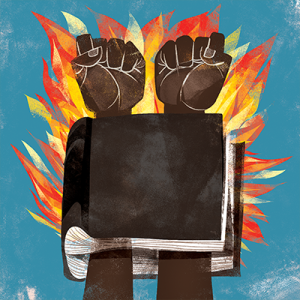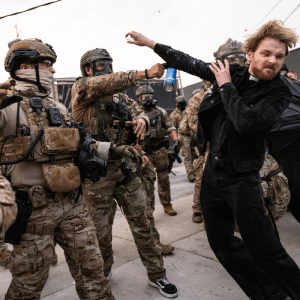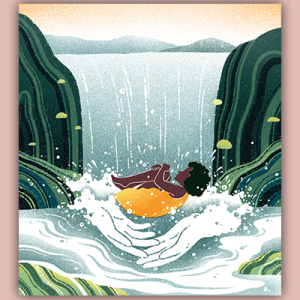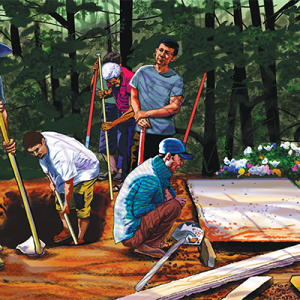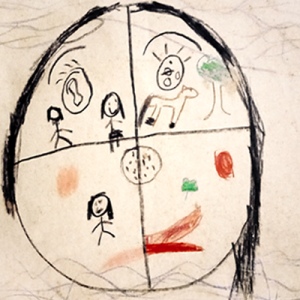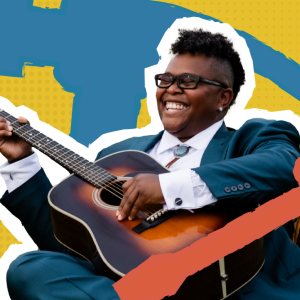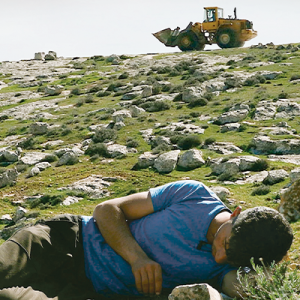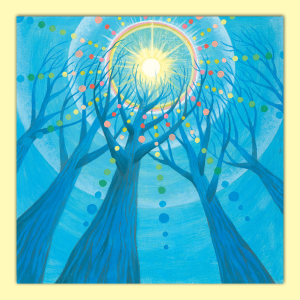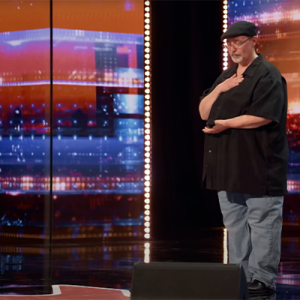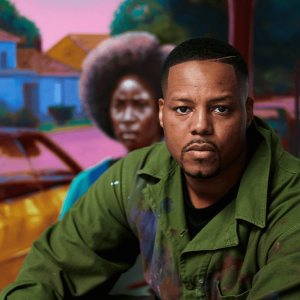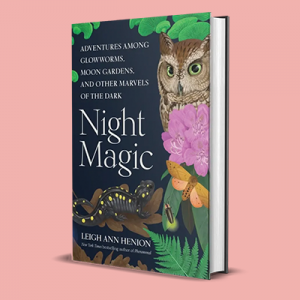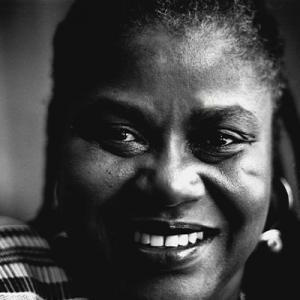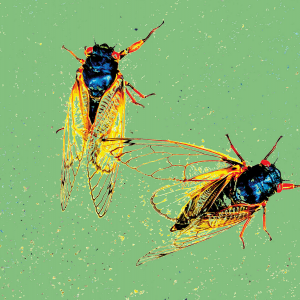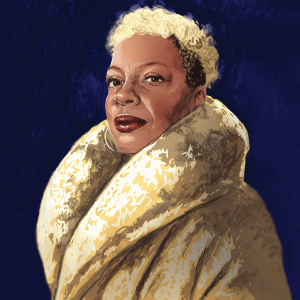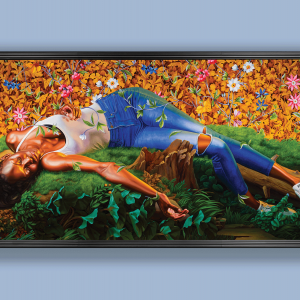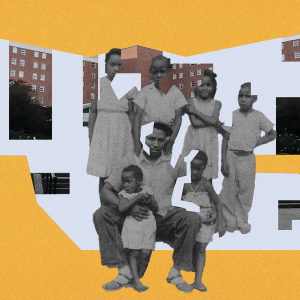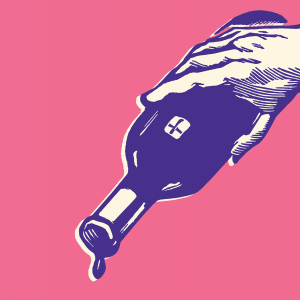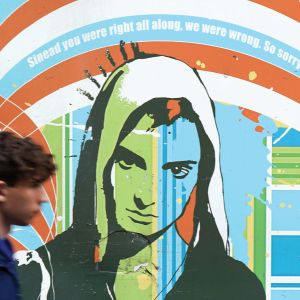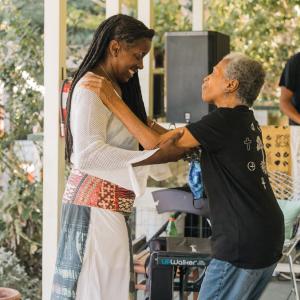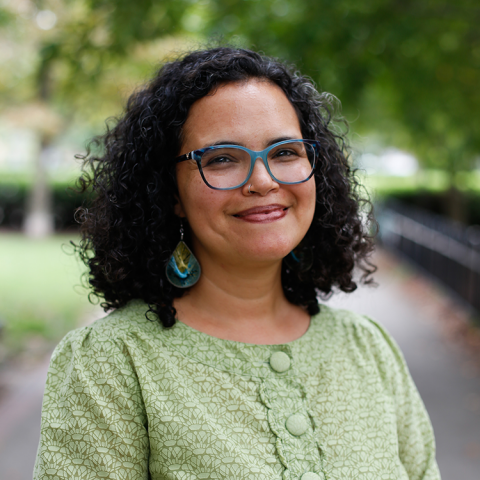
Josina Guess is an editor, writer, mother, farmer, and community organizer based near Athens, Ga. She writes at the intersection of ecology, race, history, and faith. She was born in rural Alabama and educated in Washington, D.C., public schools. While growing up in D.C., she and her family attended New Community Church in the Shaw neighborhood. As a young adult, she was a member of Woodland Presbyterian Church in Philadelphia where she served as director of children, youth, and family ministries and was trained in Godly Play. She is an active member of the Comer Quaker Meeting of Southeastern Yearly Meeting.
Before joining Sojourners staff, Josina was a senior writer and managing editor for The Bitter Southerner. She has written for Atlanta Magazine, Oxford American, Ecotone, Fourth Genre, About Place Journal, Christian Century and the anthologies Bigger Than Bravery: Black Resilience and Reclamation in a Time of Pandemic edited by the late Valerie Boyd (Lookout Books, 2022), Rally: Communal Prayers for Lovers of Jesus and Justice, edited by Britney Winn Lee (Upper Room Books 2020), Wisdom of Communities: Volume 4 – Sustainability in Community: Resources and Stories about Creating Eco-Resilience in Intentional Community edited by Chris Roth (Fellowship for Intentional Community 2018), and Fight Evil With Poetry edited by Chris Campbell and Micah Bournes (Sideshow Media Group 2018).
Along with her husband, Michael, and their four children, Josina lived and worked for six years at Jubilee Partners, a Christian hospitality community in rural Georgia. She is a contributor to the "Refugees in Georgia Oral History Project" for the Russell Library at the University of Georgia and a 2018 recipient of a Louisville Institute PSP Grant. She honed her writing and editing skills at workshops at the Collegeville Institute for Ecumenical Research.
Josina graduated from Earlham College in Richmond, Ind., with a B.A. in art concentrating in ceramics. She earned her MFA in narrative nonfiction from the University of Georgia. She loves cooking, gardening, and walking to the river with her family and dogs.
Posts By This Author
When the ‘Deeply Religious’ Burn Books
Why a Black family’s pursuit of literacy in the 1800s is relevant today.
THOUGH OTHER COUNTRIES have banned books, enforced strict censorship, and created structural barriers to education, the U.S. has a unique history of anti-literacy laws targeting Black people. During the years leading up to the Civil War, several states enacted harsh laws making it illegal for African American people, whether enslaved or free, to learn to read, to write, or to own books. These reactionary laws were rooted in a fear that literacy—especially the ability to read the Bible—would lead to violent revolt.
Layle Lane was a 20th-century educator, activist, and community organizer and a close friend of my paternal grandmother. Lane’s father, Rev. Calvin Lane, a Congregationalist minister who died in 1939, wrote about his family’s struggles and triumphs in their pursuit of literacy; his account is stored in the Howard University Layle Lane collection.
The Chicago Pastor Who Confronted ICE in a Viral Photo
The sidewalk outside of a U.S. Immigration and Customs Enforcement processing facility in Broadview, Ill., seems like an unusual place for an altar call, but that is where Rev. David Black of The First Presbyterian Church of Chicago felt moved to pray and invite ICE agents to repentance.
Since President Donald Trump launched a campaign of mass arrests and deportations in the Chicago area in September, many clergy, faith leaders, and concerned neighbors have been showing up to sing, pray, chant, lead communion, and bear witness in solidarity with people in their community who are being separated from their families, detained, deported, traumatized and forced into hiding. On Sept. 19, Black was on the sidewalk praying for ICE agents and detainees in Broadview when he and other protestors were met with violence. A Chicago Sun Times photo by Ashlee Rezin captured the moment masked ICE agents sprayed Black in the face with chemical irritants. As the image spread on social media, many people commented that the image seemed destined for history books—while others worried about whether the future will have history books.
Navigating Rough Waters With a Lullaby
Sometimes the way through is around.
I WAS SWIMMING with friends in a creek when our host led us to a waterfall where a blanket of water dumped into a deep pool. The only way to get to the small cavern behind the fall was to swim below the churning surface. My friends dove under and popped up happily behind the curtain of water. I tried, but the water pounded my back and pushed me back to where I started. The next time, I approached it sideways and reached out my hand for a friend to pull me through.
This memory was fresh when I talked with Ashley M. Jones, poet laureate of Alabama. Her latest book Lullaby for the Grieving is a collection of poems that plumb the depths of grief over her father’s passing as well as grief for the horrors of slavery in American history and ongoing genocide in Gaza.
She told me the title came during a workshop that poet Palavi Ahuja led along the Sipsey River in western Alabama. After a hike, Ahuja asked participants to write a lullaby. For Jones, a lullaby is less about how to get to sleep, and more about “describing where you are ... where you could be and giving you a pathway to pause.”
‘Folks Ought To Have a Resting Place’
The people buried in the Jubilee cemetery comprise a unique underground community wherein walls of difference crumble beneath a layer of red clay and dirt.
Jesus couldn’t afford his own tomb, and neither can thousands of people in this country. A modern funeral costs around $7,000 while the median savings for Americans in 2025 was $8,000—with many people living and dying with far less. Common U.S. practices around death, such as embalming and concrete vaults, take a huge toll not only on people’s finances but also on the environment, leaching harmful chemicals into the earth and slowing the natural process of decomposition.
Jubilee Partners, an intentional Christian community best known for its work welcoming refugees and asylum seekers, keeps a simple cemetery on its 260-acre wooded property. In addition to reducing environmental impact and financial strain, the Jubilee cemetery offers a glimpse of radical hospitality and love of neighbors, even to the very end.
Cemeteries, like just about everything in the United States, tend to be separated, by design or by default, into categories of ethnicity, religion, and class. But the 40 people buried in the Jubilee cemetery comprise a unique underground community where-in those walls of difference crumble beneath a layer of red clay and dirt shaded by a canopy of sweet gum, cedar, and pine. Of the 26 men and 14 women buried there, six died on Georgia’s death row, seven were homeless, 14 came to the U.S. as refugees, several served as pastors and missionaries, one held a Ph.D., some were illiterate, and many found solace and connection during their lives in the offbeat community that named itself after the biblical celebration of Jubilee.
When a Child Draws God
And then the nose is space / And this part is nature / And this part is people / And all of it is God.
WHEN I WAS 7 or 8, I drew a picture of God in Sunday school. I may have been given a coloring sheet, but I knew I needed a blank sheet of paper that morning. Thankfully, I was in a church that trusted and listened to children and provided me access to crayons and paper. They didn’t stifle my creative impulse. I started with a big circle and confidently mapped out a visage that was male and female, happy and sad, and reflecting all of creation. I shared it with my class and my teacher asked me to share my picture during worship, a gathering of about 40 people on folding chairs. Even as a young child, I felt like a valued member of New Community Church, one of a handful of small churches affiliated with the Church of the Saviour in Washington, D.C. It did not feel strange when my pastor encouraged me to talk about my picture in church or when the adults listened. Later, a church member and poet, Cheryl K. Hellner, interviewed me for Potter’s House Press, a small “journal of faith and the arts.” This is how I described my drawing:
I was going to draw another part right there / to make it sometimes happy and sometimes frowning / It’s divided up into four halves / On this whole half is the woman’s part / and this half — it’s the man’s / And this eye is the world, and this eye is space / This eye is really the planets / And then the nose is space / And this part is nature / And this part is people / And all of it is God.
Raised as a Preacher's Kid, Now She's a Black Butch Lesbian Writing Jesus Songs
In her personal mission statement, Matthews says she strives “to amplify the voices of the unheard, to shed light on the unseen, and to be a steadfast reminder that hope, and love are the truest pathways to equity and justice." Influenced by Bernice Johnson Reagon, Otis Redding, Aretha Franklin, Sam Cooke, Melissa Etheridge, Ani DiFranco, and, of course, Tracy Chapman, to whom she has often been compared, Matthews brings her whole self into her work.
How To Make a Mountain Move
Sometimes it takes a sprout, not a sledgehammer.
A SMALL TREE grows near the parking lot at a state park close to my home. I noticed this tree more than a decade ago when our children were very small: A sapling rooted in the crack of a giant boulder.
Over the past 14 years the split in the boulder has widened. As the tree has gotten a little taller and broader, the rock has gradually changed its shape, splitting and cracking. The tree’s bark folds around the rock; the two have become inextricably bound up with one another.
Social transformation can be slow, quiet work, like roots pushing their way through rock. It’s often hard to see the impact your life, your work, your presence, your art, your words are making on the impenetrable forces around you. Ask me to move a two-ton rock and I’ll laugh in your face; it's impossible. And yet, I remember that little tree.
Extremely heavy forces are at work in this world: racism, misogyny, greed, violence. And yet people keep finding ways — like that tree growing down into stone — to stay rooted, find joy, grow, even thrive. What if the response to these very real and very heavy stones threatening to crush our humanity is not a sledgehammer but a sprout?
Barbara Brown Taylor: On Feeding Birds, Good Friday, and Neighborliness
A conversation with Barbara Brown Taylor on finding balance and the power of resurrection.
BARBARA BROWN TAYLOR was supposed to be a poet or a short story writer. She accrued a respectable stack of rejection letters to show she tried. Instead, she became an Episcopal priest. One day, someone asked for a transcript of her sermon, and Taylor realized she had published her first story.
She went on to publish several collections of sermons or what she likes to call “spiritual meditations.” Ranked by Baylor University as “one of the 12 most effective preachers in the English-speaking world,” Taylor left parish ministry in 1997 and taught religion from 1998 until her retirement in 2017. She is the author of 15 books, including Leaving Church, An Altar in the World, Learning to Walk in the Dark, Holy Envy, and Always a Guest. She now devotes most of her attention to the farm she shares with her husband, Ed Taylor, in the foothills of the Appalachian Mountains in north Georgia, where they have lived since 1992. But she still writes. She is working on Coming Down to Earth, a book about reverence, and she shares short reflections on the beauty of life on her email newsletter with the same title.
Sojourners associate editor Josina Guess lives on a small farm in Georgia, not far from Taylor, and the two spoke in January over Zoom about caring for animals, finding balance, loving neighbors, and the power of resurrection.
Why I Watch America’s Got Talent
It’s not just to see people win.
IN HIS FIRST performance on season 19 of America’s Got Talent, Richard Goodall was shaking. The 55-year-old middle school janitor from Terre Haute, Ind., pushed his glasses up from his perspiring face. “Whew,” he said.
“Are you a bit nervous?” Simon Cowell, one of the judges, asked.
“This has been a long time coming,” Goodall replied. He patted his chest and took a deep breath.
My husband, Michael, sitting beside me on the couch, was nearly in tears, and Goodall hadn’t even started to sing.
Through Song and Railroads, Silkroad Retells the Story of the U.S.
“What happens when strangers meet?” is the driving question of the Silkroad Ensemble, an instrumental group conceived in 1998 by cellist Yo-Yo Ma. Musicians from around the world connect and communicate through music in response to this question. Lines between East and West, classical and folk blur as musicians work together to give old sounds new life. When musician and historian Rhiannon Giddens became artistic director of Silkroad in 2020, she focused the musical conversation on railroads. What emerged, and is still emerging, is American Railroad: A Musical Journey of Reclamation — a multiyear collaborative project including performances, residencies, an album, and a podcast exploring the untold stories of the people who helped lay the tracks connecting the United States.
In ‘Exhibiting Forgiveness,’ Titus Kaphar Seeks Generational Healing
In the first few moments of Exhibiting Forgiveness, La’Ron (John Earl Jelks) is beaten after he defends a store clerk in a convenience store robbery. The violence, like most of the violence in the film, is just out of view. Soon the scene shifts and Tarrell (André Holland) wakes from a nightmare. His wife Aisha (Andra Day) reassures Tarrell that he is safe in the beautiful world they are building for themselves as artists and parents.
Leigh Ann Henion’s ‘Night Magic’ Urges Us To Love the Darkness
After all, it may save us.
“LOOK FOR SHOOTING stars,” I texted my daughter who was working nights last August. After getting home around 3 a.m., she and her friend watched the annual Perseid meteor shower from our yard in rural Georgia. They saw a few faint streaks in the sky but nothing spectacular. Her friend was bleary-eyed and ready to go in, but Zora kept her eyes on the horizon. Then it happened: A streak of white with a smoky blue tail hurtled through the sky and took their breath away. Several years ago, my husband saw a similar meteor, one that lasted long enough for him to proclaim throughout its sparkly display, “Holy smoke!!!”
Meteor showers are not the only luminous rewards for those who walk in darkness. Leigh Ann Henion’s new book Night Magic (Algonquin Books) serves as both guide and advocate for honing our night vision and waiting long enough to be surprised. Synchronous fireflies, luminescent glowworms, and fragrant night-blooming flowers are among the many wonders illuminating Henion’s Appalachian nocturnal habitat
Why Bernice Johnson Reagon Taught ‘I Shall Overcome,’ Not ‘We’
Honoring the civil rights activist whose accomplishments spanned from founding Sweet Honey in the Rock to writing an opera of ‘Parable of the Sower.’
I WAS VISITING my sister and niece in Maine with my middle daughter when we learned that Dr. Bernice Johnson Reagon died. Our aunt in Oakland sent the obituary to our mom in Ohio, then Mom texted us: “Thought immediately of you both and all that she and her music meant to us. Long, lovely memories.”
Even in the news of her passing, Reagon, the founder of the celebrated music ensemble Sweet Honey in the Rock, was connecting women across generations, geography, religious, and racial categories. The music of Sweet Honey helped my mom, a white Quaker woman and Methodist pastor from rural Ohio, find her voice. It also shaped my sister and me as biracial Black women growing up in Washington, D.C. in the ’80s and ’90s. I took a course from Dr. Reagon during my senior year in high school. I never saw her again. Waves of grief and gratitude washed over me.
The day we got the news, we woke in a tent after camping near where the sun rises first over North America. As we drove past towering pine trees, taking in the news of one more passing — each death stirs up the sadness of all the other losses and more to come — my sister and I played our favorite Sweet Honey songs. We sang along to Reagon’s “I Remember, I Believe” from the 1995 Sacred Ground album: “My God calls to me in the morning dew / The power of the universe knows my name / Gave me a song to sing and sent me on my way / I raise my voice for justice, I believe.”
Lessons From Cicadas
Some see them as nuisances or pests. I marvel at them.
I REJOICED WHEN the cicadas emerged in spring of this year. My family moved to Georgia 13 years ago, missing the periodical cicadas here by a few months. This year, trillions of cicadas from two different broods emerged across 17 U.S. states. It was the first time since 1803 that those broods’ 17- and 13-year cycles were in sync. Some see them as nuisances or pests. I marvel at them. Before this year, I hadn’t heard the distinct song of Magicicada trecidem, a member of the Great Southern Brood whose droning wail prompted worried citizens in South Carolina to call the police on male cicadas for their lovesick racket. Some days I heard the constant blare as a lament for all the wickedness in the world; other times I took it as a call to prayer. Maybe that is what prayer is: bemoaning the horrors and tuning into a God who cares about everything from nations to Magicicada—and listening to a God who cries with us.
Aunjanue Ellis-Taylor’s Job Is To Tell the Truth
The actor talks with Sojourners about her recent performances, caste in America, and her relationship with the church.
AUNJANUE ELLIS-TAYLOR, known for such roles as Hippolyta Freeman in the HBO series Lovecraft Country and Mama in The Color Purple (2023), approaches her acting as an artisan, searching for the right tools with which to craft her characters, she told Sojourners’ assistant editor Josina Guess this spring. Two recent films — Origin (2023) and Exhibiting Forgiveness (2024) — feature powerful performances by Ellis-Taylor and tap into her own yearning for a world in which justice and truth prevail.
Origin (written, produced, and directed by Ava DuVernay) is a biographical drama inspired by Pulitzer-winning journalist Isabel Wilkerson’s process of writing Caste: The Origins of Our Discontents (2020). The film depicts a quest for the origins of why we separate ourselves from one another, even though it destroys us physically, spiritually, and politically. For her moving performance as Wilkerson, Ellis-Taylor traveled to Germany and India, tracing Wilkerson’s observations about the connected histories between Nazism, the caste system, and racism in the United States — deepening our understanding of these bitter human wounds.
Exhibiting Forgiveness is an autobiographical film written and directed by artist Titus Kaphar, whose process-oriented works on canvas, sculpture, and film reveal the layered reality between history and the present. In Exhibiting Forgiveness, an artist named Tarrell experiences rising success while haunted by flashbacks of a childhood riddled with addiction and family violence. Ellis-Taylor plays Joyce, the artist’s mother, who begs her son to forgive because “it’s what the Bible says.”
Both films invite viewers to wrestle with themes of reckoning and healing on a personal and societal level. Ellis-Taylor spoke with Guess about the lessons of Origin in this election year, what she sees as the “burdensome” work of Black forgiveness in the face of ongoing harm, and her commitment to speaking and living into truth, including embracing her queer identity while remaining in the Black church. —The Editors
This Room Is Not for Napping
What does it mean for Black bodies to find rest in a violent world?
DID THE TRAVELER who saw me asleep on the floor of an airport prayer room think I was dead? I wore black leggings, a black hooded dress, and black socks. My black shoes were tucked neatly beside me. My puffy black jacket served as a pillow atop my black backpack. My scarf was a blanket over my face. Perhaps I looked like a shrouded portrait of death. But I was and am very alive, just tired. After a red-eye flight with a long layover, I came seeking rest.
I sought the hidden upper room, described on the airport’s website as “a calm respite before and after flights,” to restore my soul on a Sunday morning. After sitting, then kneeling, I finally curled up in a fetal position and drifted off to sleep until an employee entered the immaculate space. The keys on her hips jangled as she wiped and rearranged the holy books and beads on the altar. As she refolded prayer mats, I silently prayed for her. The jangling got closer as she announced that she needed to vacuum. I asked if I could remain in the room. She told me the room was not for napping and that a person had opened the door earlier, saw me, thought I was dead, and walked out. Dear traveler, dear prayer-room cleaner, if you are reading this, if you thought I might have been dead, why didn’t you first say, “Are you OK?”
Displaced Residents Are Getting $10,000, but Not From the State
How a local group is raising funds for the erased community of Linnentown, Georgia.
WEEDS GROW THROUGH a rusted wash pail in a thicket beside the University of Georgia’s West Parking Deck in Athens, Ga. Littered with the detritus of college life — beer cans, a condom wrapper, Styrofoam containers — this area, unlike the otherwise pristine campus, is neglected and uninviting. Walk in anyway. Look under brambles to find a bent scrap of aluminum roofing, a green Coca-Cola bottle, a cooking pot, and a plastic toy rifle. These objects, buried under vines and rotting logs, form the understory of what used to be a working-class African American neighborhood called Linnentown. Children would swing from grapevines to get across the creek. Now college students, high-rise dorms, and cars swirl above the 22 acres of the erased community. This patch of land, mostly buried under concrete and steel, was stolen from the Cherokee and Creek people first, but the people who remember the second forced removal are still alive. They can’t get their land back, but there is a growing movement for redress for communities like Linnentown.
From 1962 to 1966, the city of Athens used eminent domain under the Urban Renewal Act to force Linnentown residents out of their homes so that the University of Georgia could build three dormitories and a parking lot for their growing, mostly white, student body.
The children of Linnentown are in their 70s and 80s now. As a child, Hattie Thomas Whitehead ran from yard to yard with her playmates and sometimes snatched pears from Ms. Susie Ray’s tree. Christine Davis Johnson enjoyed pears, apples, and pomegranates from the trees in her own yard. They both remember the bulldozers running in the middle of the night, the intentional fires, and the sense of outrage when their parents and neighbors were forced to accept a pittance for their homes and land.
“It was a warm place to live,” remembered Johnson, who was 20 in 1963 when she and her newly widowed mother had to move. Johnson bore double grief that year from her father’s death and the loss of her childhood home. “No hate. My mother didn’t teach me hate,” Johnson said, as she thought about how her tight-knit community was torn asunder. “It’s gone, it’s over, don’t go back,” her mother would say to her. Against her mother’s advice, Johnson would sometimes drive through what used to be her neighborhood, just to remember.
The Revolution Will Be Dry
Dry January offers us a chance to take a break from alcohol, both for our own health and for the health of society.
WHEN I WAS a student at Earlham College in Indiana, I co-hosted an alcohol-free dance party. Fry House, which was owned by the university, held a reputation for wild parties before we established it as Interfaith House in 1997. We — a group of religiously observant and spiritually curious undergrads — wanted to bring a new spirit into our house. I had been to enough drunken high school parties that I chose not to drink in college, other housemates had parents with alcoholism, and some abstained for religious reasons. We posted flyers, twisting a beer slogan into our hook: “Why ask why? Try Fry Dry!”
When the big night came, we pushed the furniture aside, laid out snacks, turned up the music, and swallowed our pride when only one person showed up.
This memory returned when I noticed with some surprise how Dry January, which has an app called “Try Dry,” has become a global movement. In 2013, the nonprofit Alcohol Concern (now “Alcohol Change UK”) invited people to abstain from alcohol in January; 4,000 people signed up. In 2022, 130,000 people signed up, with many more participating around the world. As alcohol-related deaths, especially among women, rose in that same period, Dry January began to take hold.
‘Sinéad O’Connor Saved Our Marriage’
The timeless wisdom of ‘Universal Mother’ calls us to be gentle.
AS AN INFANT, my son Malachi inserted an “el” sound into his cries. “Ah-La,” he wailed with outstretched arms. My husband Michael scooped up our boy and crooned Sinéad O’Connor’s lyrics, “All babies are born saying God’s name” (from “All Babies,” on the album Universal Mother, 1994).
As church-going Christians, we didn’t call God “Allah,” but we recognized it as the Islamic name for the Most Divine. We heard that name in our baby’s voice. But what strange lullaby was my husband singing to our child? “All babies are born out of great pain / Over and over, all born into great pain / All babies are crying / For no one remembers God’s name.”
I came of age to O’Connor’s 1990 album I Do Not Want What I Haven’t Got, belting out every word to the hit “Nothing Compares 2 U.” I stayed up late one night during 9th grade to watch O’Connor on S aturday Night Live. I was confused when she sang a cover of Bob Marley’s “War,” itself a rendition of Ethiopian Emperor Haile Selassie’s 1963 speech to the U.N., then tore up a picture of Pope John Paul II. I did not know then that she was protesting years of rampant child sexual abuse largely ignored by the church. She wanted us to listen to the cries of children.
The Spiritual Satisfaction of Freely Gardening
“Our little farm joins other plots of liberation, places of healing for people and the land itself.”
“DO YOU MAKE any money from it?” a visitor asked as we walked behind my house, where goats, chickens, fruits, and vegetables grow among the weeds. I shook my head and laughed.
We entered the garden where my 74-year-old father knelt, breaking up soil with an old cultivating fork. He was planting spindly tomato plants I had started from seed and almost abandoned.
We don’t make money from it, but the garden is the place where my father cultivates joy. When I was a child, he poured water on rows of collards to wash away stressful days working for a Washington, D.C., nonprofit. Gardening restores his soul. These days, Dad splits his time between my parents’ home in Ohio and my home in rural Georgia, planting gardens in both places.
We don’t weigh the bushels of okra, cantaloupe, peppers, watermelon, and beans to see if they equal or surpass expenditures of time or money spent on Dad’s trips down South. Some work can’t be measured in dollars.
